The Dell XPS 15 9550 Review: Infinity Edge Lineup Expands
by Brett Howse on March 4, 2016 8:00 AM ESTSystem Performance
The XPS 15 is offered with three processor choices. The base model is the 35-Watt Intel Core i3-6100H, which is a dual-core Skylake chip with a 2.7 GHz frequency and 3 MB of cache. While I’m sure that it’s fine for most tasks, the base model is also lacking a discrete GPU and means you are only going to be using the integrated graphics, which in this case is the HD 530. I would expect the bulk of Dell’s sales to be the Core i5 and i7 models, which also come with the NVIDIA GeForce GTX 960M graphics card. The Core i5-6300HQ is a quad-core, 45-Watt part, that runs between 2.3 and 3.2 GHz, and it has a 6 MB cache. The top option is the Core i7-6700HQ, which includes HyperThreading (the Core i5 lacks this but the Core i3 has it) and a base frequency of 2.6 GHz with a turbo frequency of 3.5 GHz. The Core i7 is the model that was provided to us for this review.
On the memory side, this device includes two SODIMM slots which is a nice bonus for upgradability. The base offering is 8 GB of DDR4-2133, and you can buy it with 16 GB as well, or if you want to add your own DIMMs you can put 32 GB in this machine. For storage, hybrid hard drives are at the low end of the device range, but Dell ramps up to PCIe based SSDs on the higher priced models. The review unit has a PM951 Samsung drive, which is the TLC version that we’ve already seen in many notebooks this year. Read speeds are generally great, but write speeds will be among the slower PCIe SSDs thanks to the TLC.
I’ve run the XPS 15 through our standard notebook suite, along with a couple of other tests as well. All laptops in the charts below are from our Notebook Bench, and if you’d like to compare the XPS 15 to any other device we’ve tested, please check it out here. The previous generation XPS 15 9530 in the charts has the Core i7-4702HQ processor, GTX 750M GPU, 3200x1800 display, and a 91 Wh battery. The Lenovo Y700 is a device that we just reviewed and has the same CPU and GPU as the XPS 15 9550, and I thought it would be interesting to also see the XPS 13 here as well, although this is the Broadwell version we reviewed last year. This is a Core i5-5200U CPU, 3200x1800 display, and 8 GB of memory.
PCMark
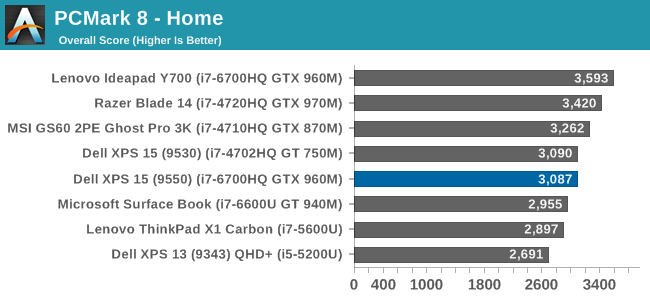
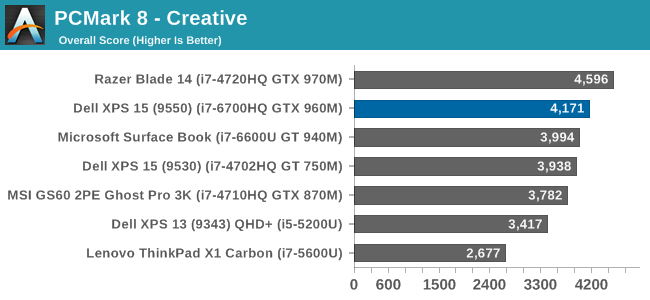
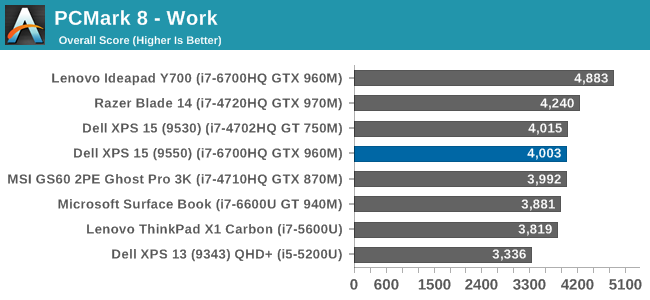
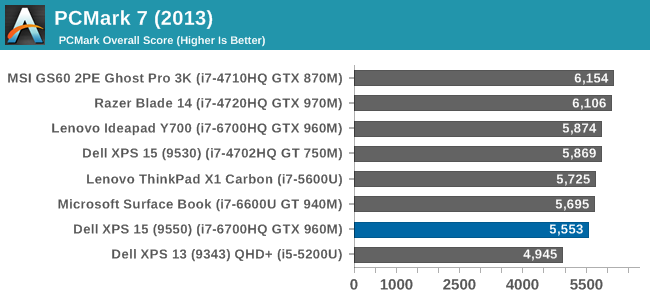
PCMark attempts to recreate actual workloads that people would use every day, and with version 8 they have several tests to focus on workloads for those tasks. Home includes web browsing, gaming, photo editing, and video chat. Creative has web browsing, photo editing, group video chat, transcoding, and some gaming, and Work has document editing, spreadsheets, and video chat. Pretty much all aspects of the device are tested, and even things like the display resolution can impact the score. The UHD resolution on the review unit impacts these scores quite a bit in fact, with the XPS 15 often quite low compared to the Lenovo Y700 which has the same CPU and GPU but a 1920x1080 display.
Cinebench
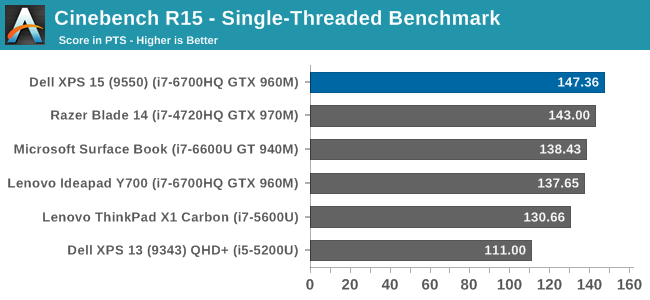
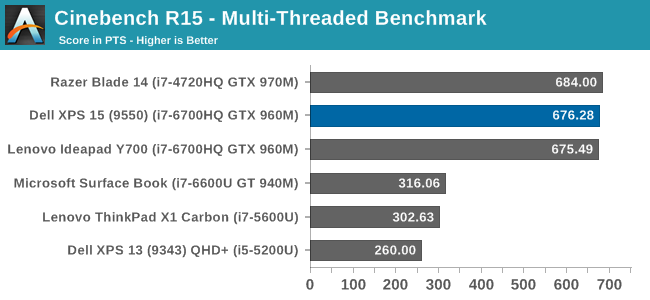
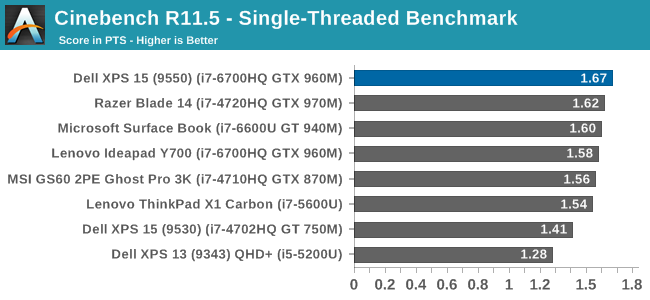
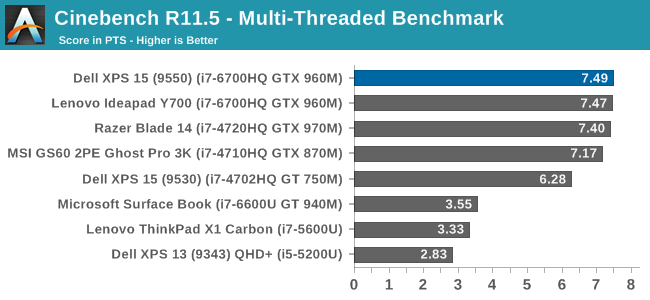
Cinebench is a CPU heavy workload which renders an image. It can use all cores and likes more MHz as well. Just like the Lenovo Y700, I found the XPS 15 wasn’t a big jump in performance with Skylake compared to Broadwell and even some of the later Haswell Core i7 parts. It is however a sizeable jump over the outgoing XPS 15 9530.
x264

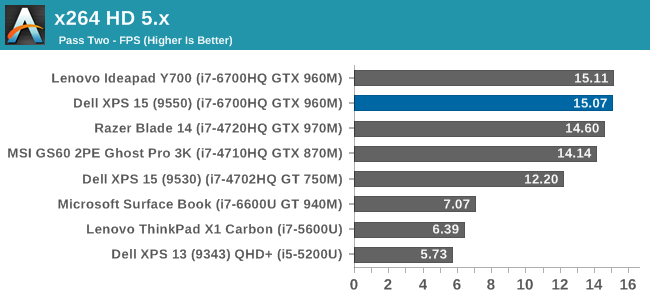
This test does video transcoding, and much like Cinebench is strongly influenced by CPU performance. More cores and higher frequencies are the name of the game here. Just like Cinebench, there also isn’t an increase in performance with Skylake on these tests compared to Broadwell or later generation Haswell chips like the i7-4720HQ, which can turbo up to 3.6 GHz compared to 3.5 GHz on the i7-6700HQ. But it is still a big jump over the i7-4702HQ found in the XPS 15 9530.
Web Tests
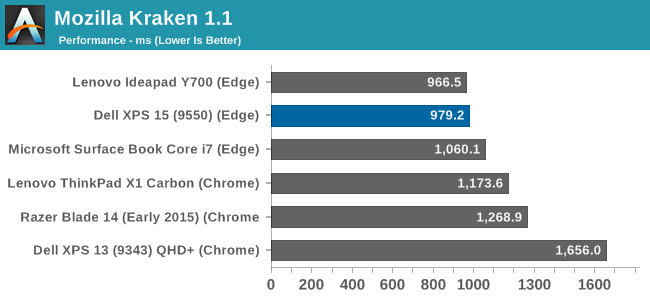
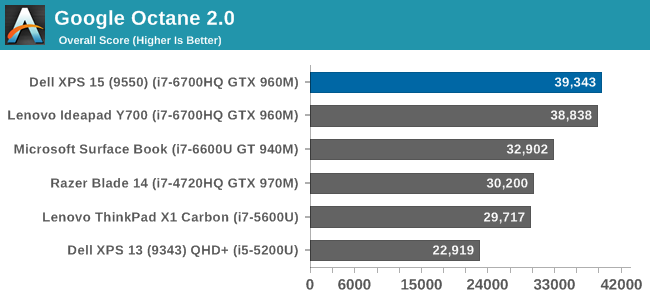
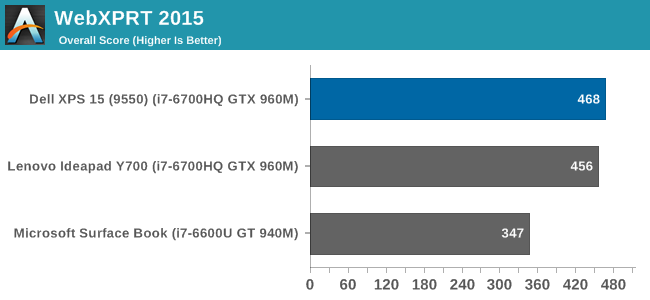
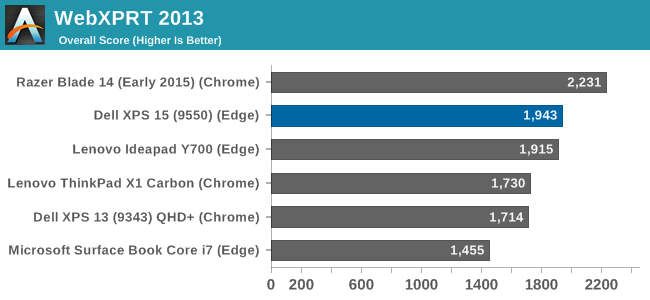
I’ve mentioned this a few times already but its worth repeating. Since the launch of Windows 10, we’ve switched from using Google Chrome for web testing to Microsoft Edge. Edge has performance that is quite a bit closer to Chrome now, surpassing it in some tests and behind in others, but both are capable browsers. As such, I’ve labeled the older laptops to let you know which browser was used at the time they were tested.
With a quad-core Skylake processor, which now supports Intel’s Speed Shift technology, the XPS 15 scores very well in our web results. The bursty nature of the web tests really plays into the hands of Speed Shift and lets the processor quickly get up to maximum frequency to perform the task, and make for a more responsive browsing experience.










152 Comments
View All Comments
Hulk - Friday, March 4, 2016 - link
It's really not that hard. 1. Always use a tripod. 2. White balance when shooting (white card) or in PS. 3. Go full manual or aperture priority to get the exposure right, spot meter. 4. Shoot the sweet spot of every lens which is generally f/8. Again use the tripod and timer so you can deal with long exposures which will be necessary.It's not like you're shooting a moving kid or portrait.
Beany2013 - Saturday, March 5, 2016 - link
To be honest, the best way to get an amateur to take better photos is to hunt down a professional photographer and find out how much they'd charge for a consultation. Given that AT isn't a professional photography site, I'd wager most wouldn't mind not being the ones taking the photos, and would appreciate letting an interested amateur pick up some tips from the trade to improve their overall craft.I've been trying to get a semi-client of mine who operates a photobooth to do this for near three years now (I'm not a pro snapper so I don't feel I can teach him well enough) but he still doesn't do it - presumably, texting me is cheaper as I only charge in coffee and cake ;-)
But it's definitely worth a pop. Taking a usable photo is fine, taking a really nice, professional *looking* photo is very much it's own reward.
I agree with other commenters that the main meat of the article is definitely the words though; these photos might not be studio quality, but they're plenty clear enough for their purpose. Having them a bit nicer would be a bonus, and as a techy person and amateur snapper myself, I'm pretty certain Brett would enjoy learning how to bodge some nicer pics in - it's a lot of fun messing with this stuff with 'our' analytical kind of mindset.
Shadow7037932 - Saturday, March 5, 2016 - link
Here's the thing, you don't need $10k in gear to take good photos. You can get a refurb D3200/D3300 (~$330-350) with a fast standard zoom with good sharpness (Sigma 17-50 f2.8 OS HSM) for ~$300-350. Add in an off camera flash or two (~$60-70ea). Add in a CPL filter (~$50-60 for a good one) for dealing with reflections and a light box (~$40-50 for a large one) and you're all set.As far as white balance and other things goes, shoot RAW, and deal with it in post. Or do it in camera using the custom white balance.
nagi603 - Monday, March 7, 2016 - link
As someone who has invested into photography, you don't need 10k. Not even close. Frankly, your micron shot doesn't even have correct white balance. Fixing that would be a breeze if you shoot in RAW, use the same temperature lights, and used any post processing software. And yes, I've been there, I did shoot stuff as a journalist. Now I'm shooting events as a hobby, so I know what I'm talking about.tuxRoller - Sunday, March 6, 2016 - link
It's too bad the Verge doesn't spend as much time on article content.Brett Howse - Monday, March 7, 2016 - link
Photography is clearly not my strongest suit, but I've got some things I will try for the next review which I hope will help with the photos. Laptops are not the easiest thing for my to photograph and get a good result. Please bear with me as I try to step up my game on the images.trenchtoaster - Friday, March 11, 2016 - link
I have been reading AT for years now and this is the post which drove me to create an account and comment. I literally have no idea why the image you linked is any better than the ones from the article that you posted previously. What makes the image you linked so much better? I feel like I am missing somethingsircod - Friday, March 4, 2016 - link
I didn't notice it until you pointed it out, but that is pretty bad. Looks like he is shooting on a Canon EOS Rebel T4i, which apparently doesn't correct geometric distortion on its JPEGs.Brett Howse - Monday, March 7, 2016 - link
That's exactly what I am using, and apparently it does not. I, as an amateur photographer, did not even notice the distortion until it was pointed out, but I'll try to avoid it in the future.close - Monday, March 7, 2016 - link
You think someone buying a $1500+ laptop takes the decision based on how the pictures of the laptop look like on a website? Maybe people will assume the laptop is all bendy and with uneven color, right? I mean it's obvious they made one side of the laptop too bright and the other too dark.You go to a review site for he things you can't see in the store, not for some glamour shots. Yeah, of course they could be better but personally I don't think this subtracts anything from the value of the review.
Also going for the IQ argument because you think the picture looks bad makes you look even dumber than your idea that "people won't buy the laptop if the picture wasn't shot RAW".